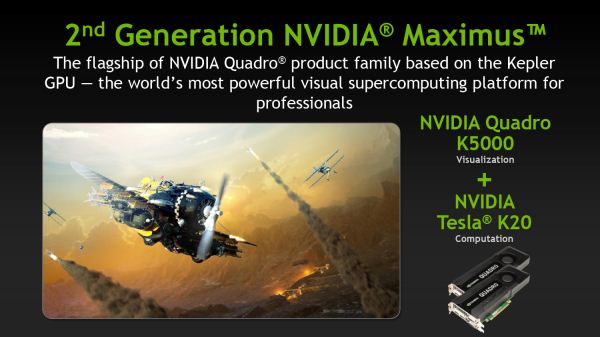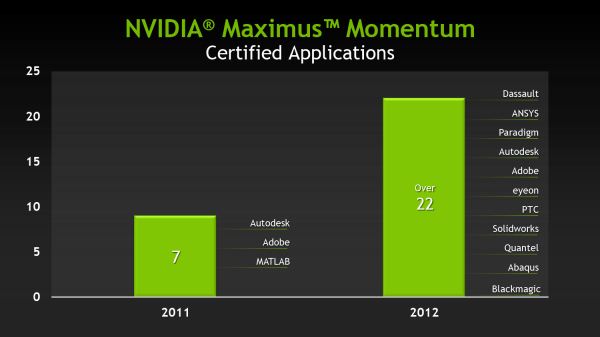NVIDIA Announces Kepler-Based Quadro K5000 & Second-Generation Maximus
by Ryan Smith on August 7, 2012 10:00 AM ESTSecond Generation Maximus
NVIDIA’s second announcement of the day directly ties into the Quadro announcement, which is the announcement of NVIDIA’s second generation Maximus technology. Strictly speaking this isn’t a new technology in and of itself – it’s the same concept of using a Quadro card and a Tesla card together in a single system and is based on the same software – but for marketing purposes NVIDIA is going to be separating Maximus based on the generation of the video cards involved.
From here on NVIDIA’s first generation Maximus technology will refer to pairing together Fermi cards, e.g. Quadro 6000 paired with a Tesla 2075. Second generation Maximus on the other hand will refer to pairing together Kepler cards, specially a Quadro K5000 with a Tesla K20.
The significance of this announcement isn’t in the branding itself, but rather what it represents for NVIDIA. Because NVIDIA is not launching a GK110 Quadro card (or at least not yet) Maximus’s importance in NVIDIA’s ecosystem has been greatly elevated virtually overnight. For the Fermi generation all of NVIDIA’s high-end Quadro cards were capable of both high performance rendering and high performance compute, with the Quadro 6000 in particular being a superset of both the Quadro and Tesla families by offering NVIDIA’s best graphics performance combined with their best compute performance. Maximus improved the experience by offloading compute onto a Tesla card – and thereby bypassing the performance penalty of frequently context switching – but Maximus wasn’t strictly necessary for high performance compute with Quadro.
Second generation Maximus on the other hand sees Maximus become essential to compute performance. Because of GK104’s limited compute performance, Quadro K5000 cannot achieve high compute performance on its own; at best it’s a great graphics product and a decent single-precision compute product. Instead Quadro K5000 needs to be paired with a GK110 Tesla card in order to achieve both high graphics performance and high compute performance. Second generation Maximus in turn is the technology and branding glue that brings all of this together.
As we mentioned in our quick look at the Quadro K5000, NVIDIA going this route isn’t particularly surprising given the fact that GK104 is such a strong performer at graphics tasks and is far more available than GK110, but it means that NVIDIA is now very reliant on Maximus in all situations that call for a Quadro video card with strong compute performance. It also means that NVIDIA is at the mercy of application developers to a certain extent as developers need to specifically accommodate Maximus. To NVIDIA’s credit the number of programs supporting Maximus has more than tripled in the last year, but that’s still a far cry from the hundreds of applications professionals typically use.
For this reason we wouldn’t be shocked to eventually see a GK110 Quadro card, but until that time this is NVIDIA’s flagship graphics + compute solution.












29 Comments
View All Comments
ltcommanderdata - Tuesday, August 7, 2012 - link
Seeing that GK110 Tesla won't likely be shipping in volume until next year, while the Quadro K5000 will be available a few months earlier, I wonder if nVidia supports a "Maximum 1.5" setup pairing the Quadro K5000 with a Fermi based Tesla?silverblue - Tuesday, August 7, 2012 - link
I think if Intel did that (as unlikely as it is to happen), they'd quickly find themselves hauled in front of the US and EU courts and be split up. Getting caught against AMD was one thing, repeating it against NVIDIA is quite another.XZerg - Tuesday, August 7, 2012 - link
I would believe AMD is much more passive and Nvidia being much more aggressive when they need to defend themselves. It has been proven in the past and would bet it would happen again if Intel did something that dumb.bigboxes - Wednesday, August 8, 2012 - link
It's funny that yesterday AT posts nVidia's new professional cards, while other sites show AMD's new offererings. I find that passive aggressive.mayankleoboy1 - Tuesday, August 7, 2012 - link
Any news on if GK110 will be present in consumer gaming cards ?dragonsqrrl - Tuesday, August 7, 2012 - link
I just can't imagine Nvidia not using it in their high end gaming cards. Developing a Tesla/Quadro only GPU, then developing a separate GPU specifically for high-end gaming would be extraordinarily costly, even if both are based on the same architecture.johnthacker - Wednesday, August 8, 2012 - link
Well, I suspect that NVIDIA will use it in a high end gaming card only if and when they need to to compete with AMD, and only if it turns out to be a better option than, say, a shrink or reconfiguration of GK104 (a GK114) for better performance. While development is costly, optimizing the hardware for graphics versus compute can make it worth it.On another level, look at the price (and thus gross margin) for NVIDIA on those Quadro and Kepler cards. Keeping GK110 in Quadro and Kepler only gets a lot of people doing Compute to fork over the cash, instead of doing GPGPU on the cheap with GeForce cards. I can tell you that there was an audible sigh of disappointment at GTC2012 when audience members asked at the "Inside Kepler" talk whether all these cool new Kepler features aimed at compute (Dynamic Parallelism, Hyper-Q, etc.) were limited to GK110 only and the answer was yes.
JlHADJOE - Thursday, August 9, 2012 - link
On the contrary, I can't imagine Nvidia using it (GK110) in their gaming cards, especially with supply limited as it is and their professional lines being much more profitable.dragonsqrrl - Thursday, January 31, 2013 - link
hmmm, Geforce Titan... what happened?
RonMLew - Tuesday, August 7, 2012 - link
Is Nvidia trying to show an anachronistic mismatch on purpose? The move visible plane is a Soviet Polikarpov I-16, which was active from the mid-1930s until the end of WW2. the colors are odd and it looks like there are two surface to air missiles.